Sometimes, it’s difficult to pin down a particular recipe to one given location, especially with today’s relatively new national borders.
Count kashata, a delectable Swahili peanut brittle-esque dessert, as one such recipe. Yes, it’s a common snack and street food in abundance around Tanzania, but the recipe itself – much like the overarching Swahili culture – spans far greater swathes of Eastern Africa than do Tanzania’s boundaries.
And in this way, kashata belongs to an entire (really, really large) cultural region… not necessarily one modern nation-state.

Kashata, Swahili Culture and the Local Cuisine
Our story begins today in the “Cradle of Mankind,” an area of land in modern-day Tanzania that many archaeologists consider the birthplace of our modern species. If that’s not hard enough to fathom, there have been remains discovered of hominids from 3.8 million years ago discovered in this area.
Needless to say, but the Cradle and eventually the greater East African region, is as original of a “cultural hub” as we’re going to get in our human history. Far before any other civilizations began setting up trading routes with others, hunter-gatherer communities in Eastern Africa were already well-seasoned in interacting with one another.
The foundation for the Swahili culture, however, didn’t come until only 2,000 years ago, when the first Bantu peoples started a migration from West Africa to East.
If you love this recipe, you’ll love our Kenyan Beignets donut recipe, complete with dipping sauce!
First Bantu…
The arrival of the Bantus marked a pivotal point in the development of Eastern African communities. To this point, the Bantus had already mastered the art of ironworking and had developed robust political and social structures that laid the groundwork for more modern societies.
As a result, the entire East African coast was well prepared for incoming traders from faraway lands upon their first arrival in the 2nd century AD. Ancient Greek texts like Ptolemy’s Geography paint a picture of bustling marketplaces and even full-fledged metropoles upon the Greeks’ arrival on the coastline. This notion of a trade-heavy society so early on is bolstered by the archaeological discovery of Roman-era coins along the coast as well.
…Then Swahili
Things really picked up from the 6th century onwards, however, with the arrival of the likes of Persian, Arab and Indian traders. Merchants came from all over to trade valuable items like ivory, gold, beads, salts, local spices and (unfortunately) slaves. For nearly a full millennium, the Swahili – derived from the Arabic word sawahili meaning “coasts” – denoted the East African coastlines spanning from Mogadishu in modern day Somalia down to the Rovuma River in Mozambique rife with prosperous trading activity for all. The presumed “golden age” of the Swahili was in the 12th-15th centuries, when cities like Kilwa on the southern Tanzanian coast became a crucial hub for all Indian Ocean-African-Arabian trading.
Of course, such continued and open exposure to outside cultures had an effect on the local peoples, and so the Swahili language and culture was born. While still technically based in indigenous Bantu-based culture, Swahili evolved into a fusion of African, Arabic, Persian and even some Chinese influences to create an entirely distinct culture from the rest of the African mainland. For example, the main Swahili language, KiSwahili, is rife with Arabic loan-words alongside adapted Bantu words to create an entirely different language altogether. This development of an entirely unique and independent African culture was cemented with the arrival of Islam to the Swahili in the ~9th century AD.
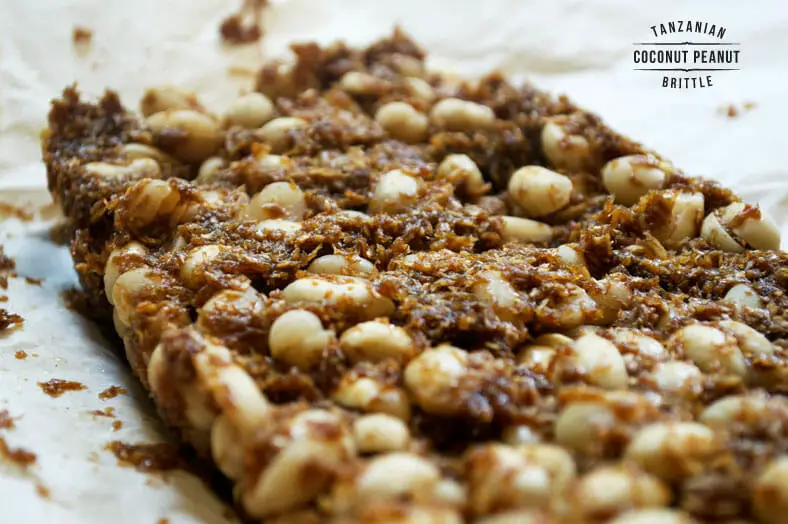
This period of prosperity for the coastlines of the Swahili ended in the 16th century with what would become a “domino effect” of colonial periods. First there were the Portuguese… then there were the Arabs… then the Brits before the creation of modern nation states in the 20th century. During the period of New Imperialism, European powers like the Germans, the Brits and the Belgians divided the Swahili and other lands according their own political interests, an effect that has led us to the different East African nations that we have today.
Nevertheless, despite these modern day national borders, the Swahili culture has gone on to signify a specific type of people, a true culture and way of life, a style of community and a lingua franca for the entire region spanning the likes of Tanzania, Kenya, Mozambique, Uganda and more.
Swahili Cuisine
Unlike other more starch-heavy and basic African cuisines, the Swahili cuisine has developed over time to incorporate interesting ingredients and techniques from African, Middle Eastern and Indian influences.
Whereas plantains or cassava might be common in other parts of the continent, rice and rice dishes is the staple grain in Swahili eating, and it is often accompanied by sophisticated stews or curry-like dishes. Spices like cardamom, cloves and chilis are used in abundance, as are locally available fresh fruits and vegetables (something less common in other African regional cuisines).
Perhaps most intriguing is the abundant use of the coconut – especially coconut milk – in various recipes… which brings us to one particularly tasty coconut-heavy dish, kashata.
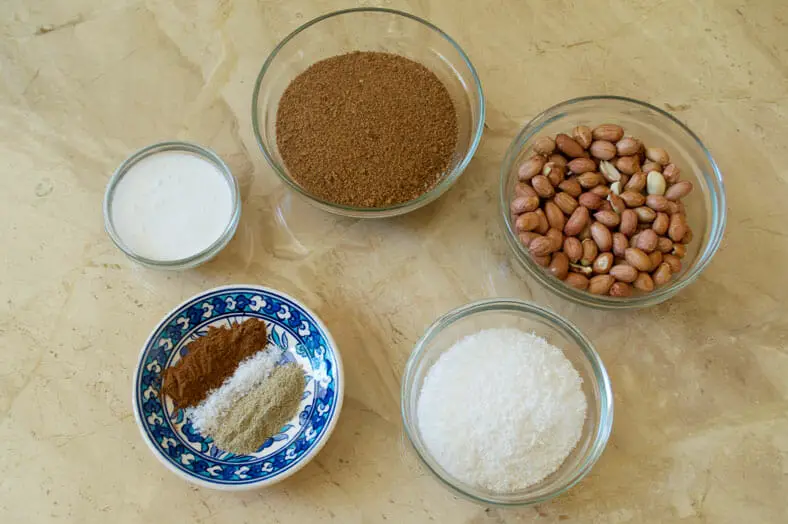
About the Recipe
Technically, kashata is a recipe that can be made with strictly coconut or strictly peanuts. Neither ingredient is really considered “mandatory” for the recipe. By the way, if you love peanuts definitely try our peanut and chicken stew, or a vegan sesame and sugar cane bites recipe from India (Tilkeladoo)
But that’s not as much fun. Kashata is far more delicious when it’s made with both, and it’s done so in a way similar to your everyday peanut brittle. However, compared to the everyday peanut brittle recipe (especially those with corny syrup in them), kashata is definitely a healthier, easier and more fun option to make.
There’s three real pieces to creating a delicious kashata: the peanuts, the caramel and the coconut.
If you happen to start with unroasted peanuts like we did, then you’ll want to start out by pre-roasting them a bit before actually making the kashata. Take the peanuts for several minutes over a medium heat as they start to roast and brown, then you can set them aside.
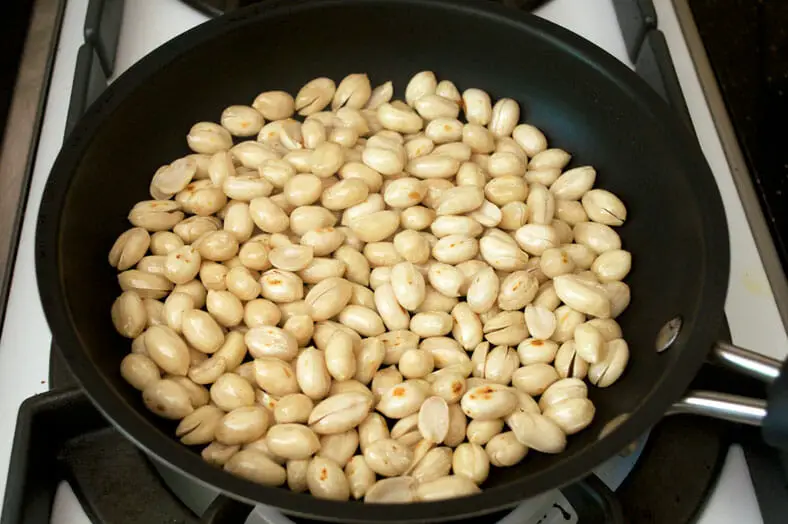
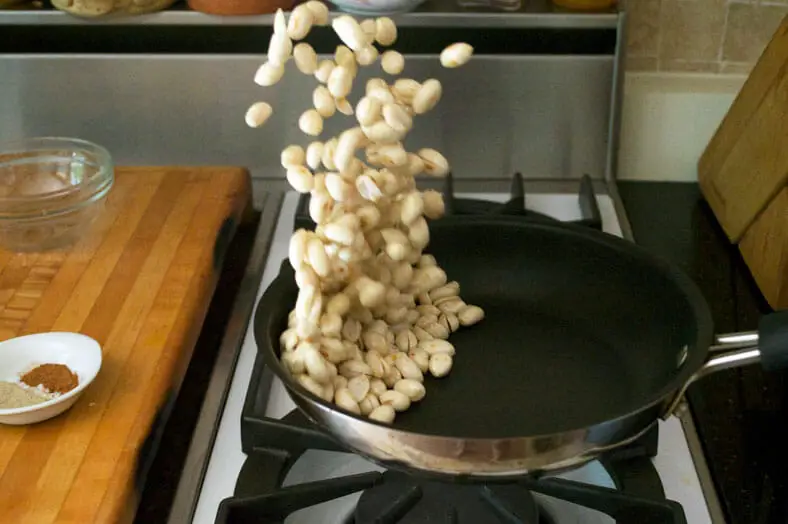
From there, you start to create a caramel made with sugar, water and flavored with some cardamom (if you’d like). Spend a few minutes melting and caramelizing the sugar over medium heat until you get a nice, thick syrup into which the rest of the ingredients can go.

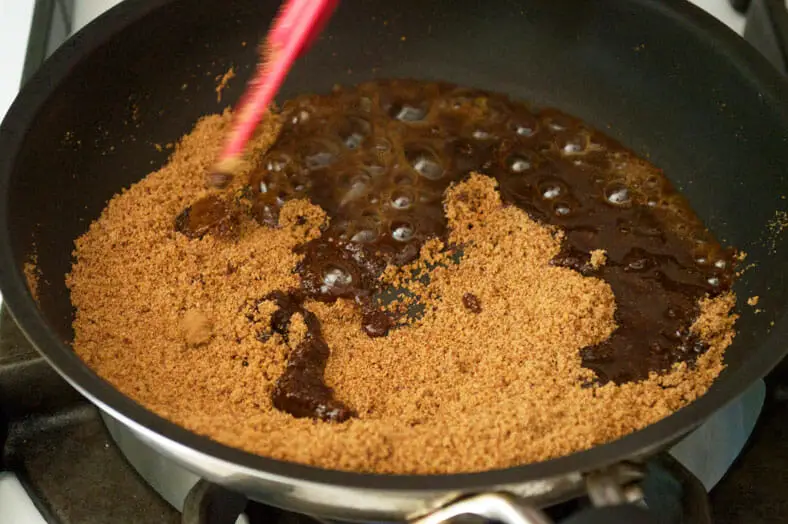
With your beautifully goopy syrup ready to go, you’ll add the rest of your ingredients starting with your peanuts. If going the coconut route, you’ll then add in slightly moistened grated coconut flakes and, if you wish, a dash of coconut milk as well. Stir well while the mixture (i.e. the caramel) is still hot and malleable.
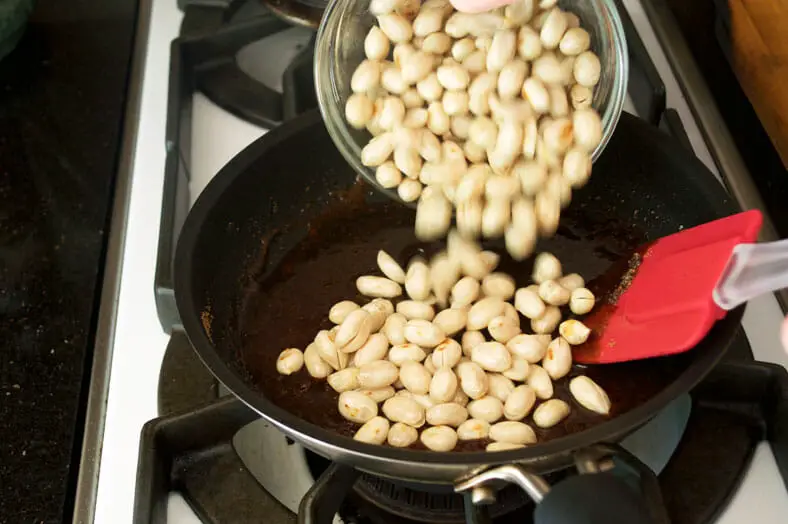
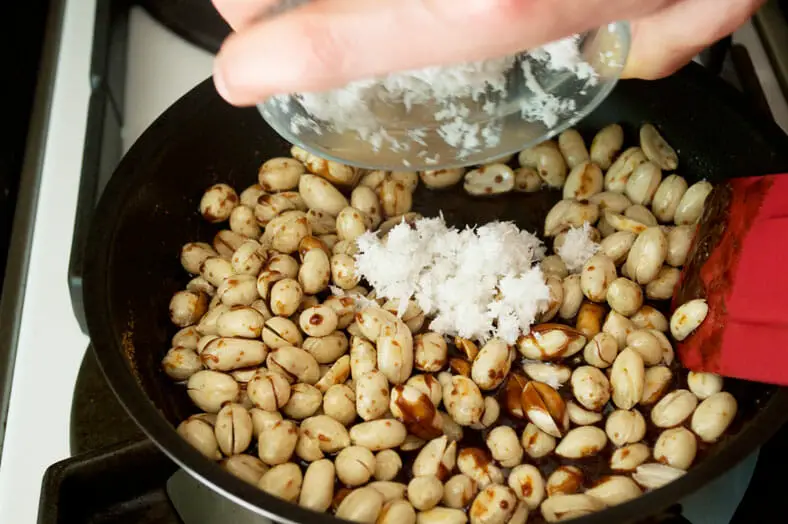
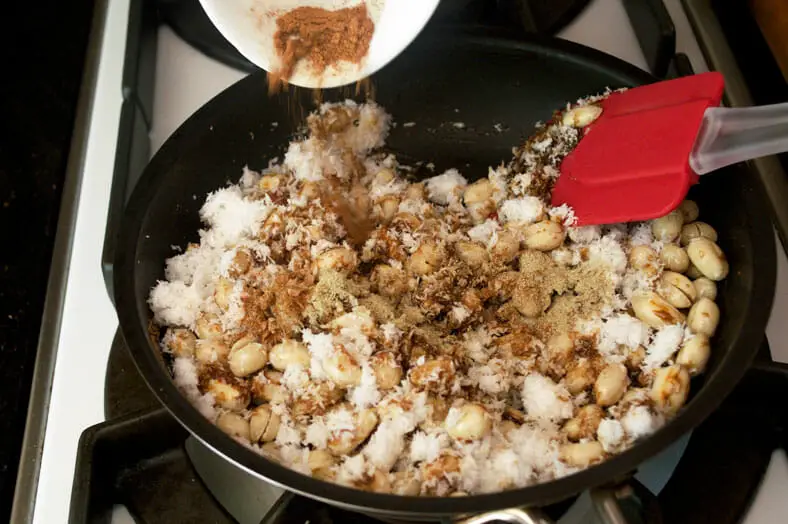
Once everything is mixed together, place into a pre-greased dish or any other surface to help the kashata cool and harden, something that should only take a few minutes. And you’re done!
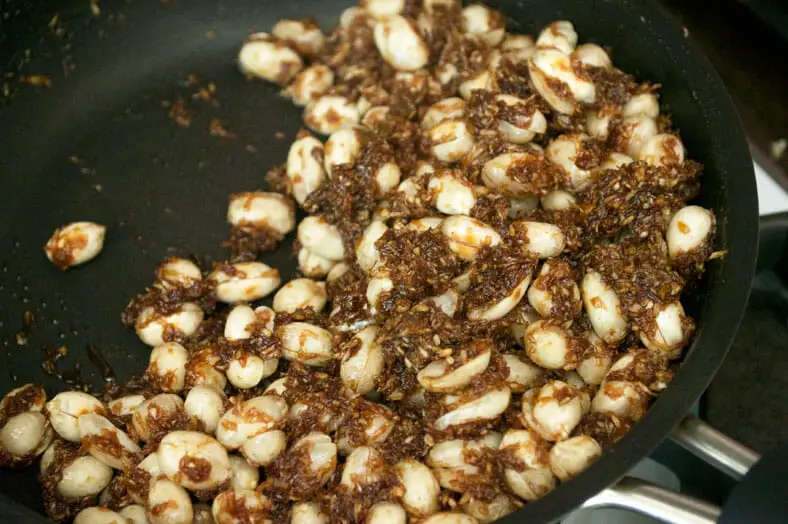
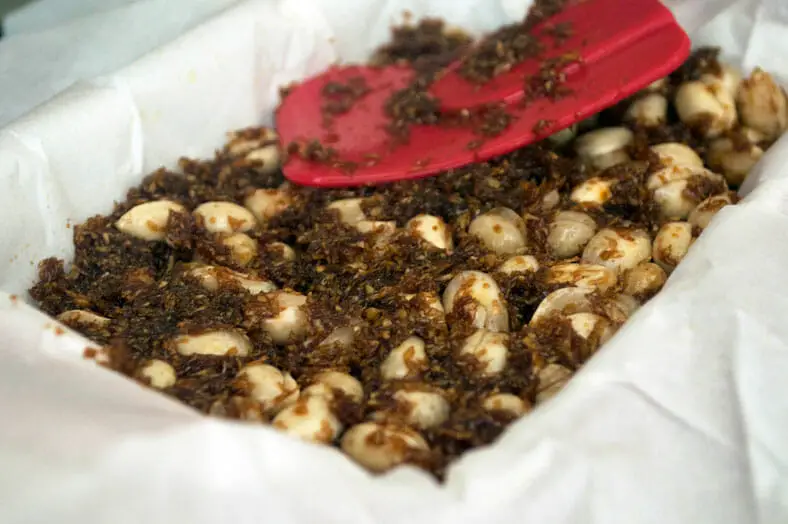
Our Take on the Recipe
Sometimes, there simply aren’t the “bingo!” recipes out there that we could consider our sure-fire source recipes. Kashata was one of those cases.
We did come across a blog that offered an authentic enough approach to kashata from which we could start, which is why we based our original source recipe from the Swahili Mom Kitchen. Still, there were adjustments to be made and improvements to be had from this baseline.
To start, we added peanuts back into our own version of the recipe. At least in our own preference, kashata with peanuts is so much tastier than kashata only with coconut. If you happen to disagree with this, though, no problem at all… just omit the peanuts and increase the amount of grated coconut by 1.5-2x.
If you do decide to go with the peanuts, we’d personally recommend roasting your own unsalted peanuts. The beauty here is that, upon roasting to your liking, you can use the same pan and leverage any residual peanut oils to add a little bit of “peanutty” flavor to you caramel.
As with every recipe involving some kind of sugar, we swapped out regular sugar in favor of coconut sugar, which fit in pretty well here amid its “coconutty” counterpart ingredients. Also, while we would’ve loved to grate a coconut from scratch, we opted for a slightly easier approach in taking pre-grated coconut and moistening it with a dash of coconut milk prior to adding it into the caramel.
Finally, we added in a dash of cinnamon. Now for the record, it is not by any means a traditional add into kashata, but we come across it in enough other recipes to pique our intrigue enough to try it. It works really well in the overall dish, which is why you see it here in our version of the recipe.
Otherwise, there’s very little else that needs to be done to an already delightful Swahili favorite. Both as a refreshing dessert and an accompaniment with an afternoon tea, kashata is an absolute winner.
Enjoy!
How would you like your kashata? With peanuts or coconuts? Comment below!


1 thought on “Kashata: Tanzanian Coconut Peanut Brittle”